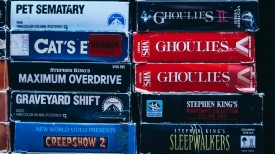Dr Sam Parnia Talks of 'Beyond Death Experiences' in his New Book
Dr. Sam Parnia, a critical care doctor and director of resuscitation research at the Stony Brook University School of Medicine addresses the topic of resuscitation in his new book "Erasing Death: The Science That Is Rewriting the Boundaries Between Life and Death."
People often wonder what happens after a person dies. Is there another life or is death the end? However, with the developments in science, some people have been revived after their heart has stopped beating. Dr. Sam Parnia has studied many such cases and talked to such people asking them about what they felt during the period that their heart stopped beating and when they were brought back to life. He shares some of these experiences with readers in his new book "Erasing Death: The Science That Is Rewriting the Boundaries Between Life and Death" and also talks to Fresh Air's Terry Gross about the book.
On a Hieronymus Bosch painting that depicts an image similar to images described by people who have had near-death experiences
"There's a very interesting painting by Hieronymus Bosch from the 15th century where he's actually painted what looks like a classical near-death experience, but in reality people didn't know about near-death experiences at that time and it certainly isn't what classical Christianity would have taught of what people would have experienced when they've died."
On why most people who are resuscitated do not have memories of lights or tunnels or mysterious beings
"We've certainly found in our studies ... that if we manage to get to patients immediately after waking up - which is not easy at times - and talk to them, they tend to remember more, and if you go back and reinterview them within a couple of days, they tend to have forgotten their experiences, possibly. So we think that probably many more people have these experiences - if perhaps not even everyone - but somehow their memories get wiped in the same way that most of us - if not all of us - dream every night, but somehow there's a disruption to the memory circuits that allow us to recall our dreams the following day."
On why doctors often put a patient on ice when trying to restart a heart
"If we cool people down by a number of degrees Celsius ... we slow down the rate by which cells - particularly brain cells - are undergoing their own process of death, because we have to remember that cell death takes place through chemical steps. So, from our high school chemistry days we all know that chemical reactions need heat, and if you take away the heat, that slows down the chemical reaction."
On questioning the things people report having seen during near-death experiences
"The experience that people have is very personal and it's very real to them. So, for most people who've gone through these experiences, as far as they're concerned, what they've experienced is absolutely real. They've described and seen something of the other side. Now, for those of us who haven't had the experience, it's impossible to verify that, but in the same way that, for instance, if a patient comes to me and says, 'I have depression,' it would be completely unacceptable for me as a physician to simply discard that experience and say, 'Well, I don't think [so]. You may feel that you're depressed, but actually it's an illusion of having depression or you're hallucinating. Your depression, it's not really real.' So we have to remember that to the people who've had the experience, it's real to them."
© 2023 Books & Review All rights reserved.
Popular Now
1
Books to Read After 'Fourth Wing': Top Picks for Fantasy and Romantasy Fans

2
‘The Secret Public’ by Jon Savage Book Review: An Insightful Look Into the LGBTQ Influence

3
Stephanie Regalado's 'If They Only Knew' Column Is Now A Book, Unleashing 60 Anonymous True Stories to Empower Women

4
'No Wire Hangers' Scene That Almost Did Not Happen: New Book Reveals Faye Dunaway's Struggles

5
Rare First Edition of Aphra Behn's Novel 'Oroonoko' Discovered in Kent: A Historic Literary Find

Latest Stories
Book Reviews
‘The Secret Public’ by Jon Savage Book Review: An Insightful Look Into the LGBTQ Influence

Book News
Stephanie Regalado's 'If They Only Knew' Column Is Now A Book, Unleashing 60 Anonymous True Stories to Empower Women

Book News
'No Wire Hangers' Scene That Almost Did Not Happen: New Book Reveals Faye Dunaway's Struggles

Book Reviews
‘The Perfect Couple’ by Elin Hilderbrand Book Review: A Captivating Summer Mystery

Book News
New Book ‘The Franchise’ Reveals Penguins President Kyle Dubas’ ‘Biggest Mistake’ as Maple Leafs GM











